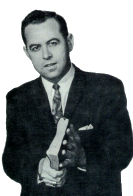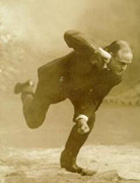The Invitation
(Chapter 12 from Dr. Hyle's excellent book, Teaching On Preaching)
Immediately when we think of the word "invitation" we think of a song such as "Just As I Am" or "Softly and Tenderly" or "All to Jesus I Surrender." We think of folks coming forward to receive Christ as Saviour or to present themselves for church membership or perhaps believer's baptism. However, the invitation starts a long time before the end of the sermon. Basically, the invitation is the response of the audience to the service and message. This response should begin before the service ever starts. Consequently, the invitation begins before the service ever starts. Following is a step- by-step explanation of what the invitation really is.
1. The invitation begins when a hand of welcome is extended at the door. When a member of the church reaches forth his hand, he is asking for a response. When the visitor extends his hand for a warm handshake, he is responding, and the invitation has begun! This is why it is so important for there to be a friendly, relaxed atmosphere in the early part of the service. This beginning of the invitation is hindered in churches that do not encourage fellowship before the services. There seems to be a certain kind of feeling that the church building is where God lives and that we come by to see Him every week. Therefore, the church house is a place of austerity and quietness, and to fellowship and shake hands is irreverent. Nothing could be farther from the truth! Spurgeon called the church building simply a meeting place. God does not live inside the church building any more than He lives inside your home.
To be sure, there was a Shekinah Glory that dwelt over the Holy of Holies in the temple and in the tabernacle. This Shekinah represented God's presence with His people. There is still a temple, but that temple is not a church building.
The temple today is the body of the believer. I Corinthians 6:18-20, "Flee fornication. Every sin that a man doeth is without the body; but he that committeth fornication sinneth against his own body. What? know ye not that your body is the temple of the Holy Ghost which is in you, which ye have of God, and ye are not your own? For ye are bought with a price: therefore glorify God in your body, and in your spirit, which are God's." The church building is not a temple, or for that matter even a sanctuary, which means a place where God dwells. It is a meeting place where God's temples come to meet each other. A warm handshake and a "God bless you" are always in order. When a friendly greeter or usher or a happy member extends his hand to a visitor, the invitation has begun! He is beginning to respond. We trust that this will lead to total response which will lead to responding to the invitation of receiving Christ as Saviour.
2. The prelude is apart of the invitation. It, too, should invoke a response. For this reason, it should be familiar hymns or Gospel songs. It should not be classical music. Now I'm not criticizing the classics. I love them, but a church service is no place for them. There is no way that it can lead to a response, but if the organist or pianist is playing "Blessed Assurance" or "Leaning on the Ever- lasting Arms," people can hum along, at least in their hearts. Even thinking of the words that are being played is a response. Hence, it becomes a part of the invitation.
3. The song service is a part of the invitation. When the song leader announces the number and the audience turns to that number; it is responding to the song leader, and the spirit of responding is being increased. When the song leader asks the congregation to stand for the next song, the fact that they grant his request and stand is in itself a response and becomes a part of the invitation. The singing itself is responding. It is the audience participating. It is used by the Spirit of God to make responding easier and to make the service conducive to a response when the invitation song is sung. This is the reason that familiar songs should be chosen-songs that sing easily and that people enjoy singing. Songs such as "At Calvary;" "At The Cross," "The Old Rugged Cross," "Amazing Grace," "How Firm a Foundation," "Come Thou Fount of Every Blessing," "Rescue the Perishing," 'Sweet Hour of Prayer" and other songs that speak to the heart and invoke a response both in the heart and in the singing are certainly apart of the invitation.
4. The opening remarks by the pastor are a part of the invitation. Perhaps he says something that prompts a smile. This too is a response and helps to create a spirit of responding. This means that a warm introduction that causes the people of the audience to even have a nice thought is a part of the invitation. The people become participants with their thinking and with their acting. This Will make it easier for them to participate throughout the service and especially at the end of the service when they can find the spirit of responding an asset to their responding to the call of Christ to receive His gift of eternal life.
5. The recognition of visitors is apart of the invitation. The fact that they are asked to stand gives them an opportunity to respond. Of course, by this time they are accustomed to responding. They responded to the handshake at the door. They responded to the congregational singing. They responded to the pastor's opening remarks. Now they are more likely to respond by standing as visitors.
In a smaller church the visitors may be asked to give their names and home town. This will be difficult for them if they have not been in a service where responding is convenient and easy, but if throughout the service there has been an interaction between the pulpit and the pew, the visitor will find it far easier to give his name when he is recognized as a guest.
6. The offering is a part of the invitation. When the plate is passed and the guest accepts it and passes it on, he is responding. When he places a gift (regardless of the size) into the plate, he is responding.
7. Responsive reading is a part of the invitation. At the First Baptist Church in Hammond we always do this in our Sunday morning and Sunday evening services. The people stand and read either responsively or in unison a portion of Scripture. This is apart of the invitation. We have invited them to respond, and they are responding. They do so readily by this time, if the service has been one conducive to response.
8. Humor is a part of the invitation. Humor, in good taste, is an excellent way to invoke response. Something is said from the platform, and people smile, chuckle or laugh. They are responding. This is one reason that humor is such a vital part of a church service. It is simply another way for the platform to seek a response and for the audience to grant it.
9. Identification with the speaker is an important part of the invitation. If the congregation feels that they are part of the sermon, if illustrations are used that pull the congregation into the speaker so that they can identify with him, it becomes easy to respond in one's mind. One of our members once said to me, "Pastor, I feel like you and I have done so many things together because the illustrations that you use are illustrations with which I can identify and I feel like apart of you when you preach." This too is apart of the invitation.
The sermon is now over. The unsaved person entered into the church and responded by extending his hand to a friendly greeter. He responded to the usher by following him to his seat. He responded to the song director by opening his song book to the number announced. He responded during the singing of a familiar song. He responded in his heart to the opening remarks. He responded with a smile or chuckle to some well-chosen humor. He responded at offering time. He responded at the recognition of visitors. He responded during the responsive reading or the reading in unison of the Word of God. For an hour or more he has been responding. Now it is time to respond to the Gospel. He is comfort- able. He feels at home. The service has not been starchy or ritualistic. The Holy Spirit speaks to him. Response has not been difficult thus far; it will not be difficult now. The invitation is begun. A song of invitation is being sung. Soon there are tears and conviction and then, praise God, a response. He is now in the aisle. He is coming to the altar. He is now kneeling with a soul winner. He is praying the sinner's prayer. He has received Christ as Saviour! He is born again! He has escaped the fires of Hell! He is on his way to Heaven! His name is written in the Book of Life! He is a new creature in Christ Jesus, and to think, even the usher at the front door had apart!




